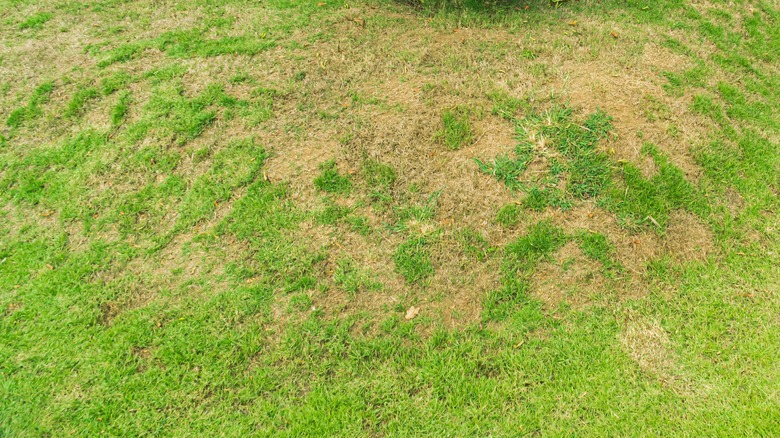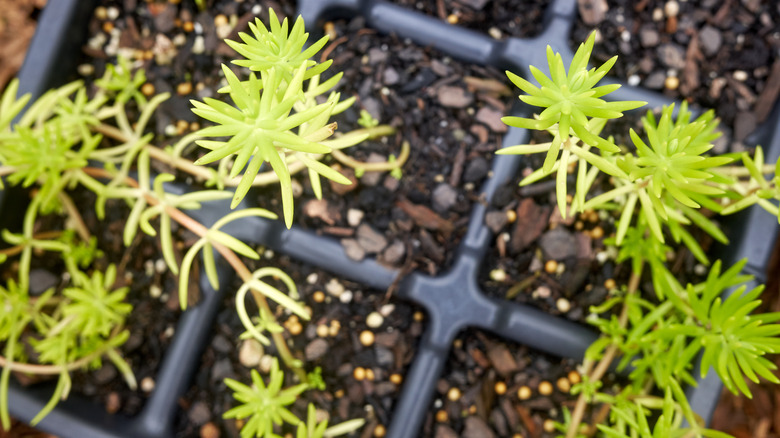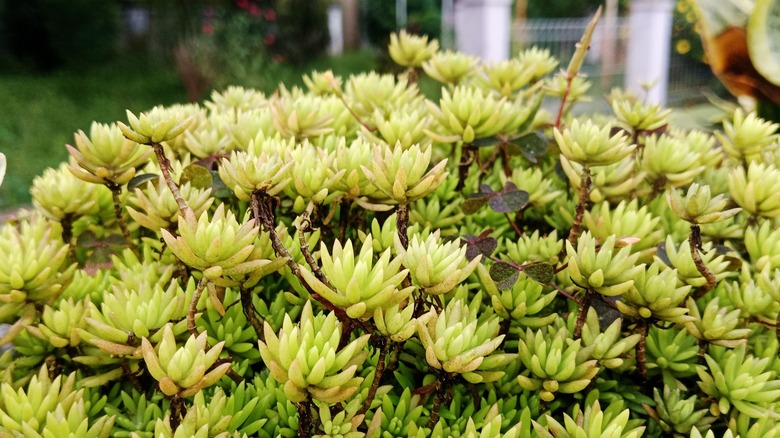The Heat-Tolerant Ground Cover That Can Fill In Patchy Grass Spots In Your Lawn
Are the barren brown spots in your lawn preventing you from having the evenly green and inviting space that you crave? It can be challenging to ward off dry patches in your lawn, especially during the heat of summer. You seed, water, mulch, and fertilize to no end. And still, those patchy spots prevail. Why not decide to go with a different option altogether instead of grass? Fortunately, there are several flowering ground covers that are good for your lawn, including the evergreen perennial Angelina stonecrop (Sedum rupestre).
This ground cover will add a beautiful contrast to the deep green of your lawn and is easy to grow. Angelina stonecrop is a low-maintenance plant with fleshy leaves that can be pointed or rounded. It quickly spreads along the ground without being invasive. This succulent grows 4 to 6 inches high and can cover up to 24 inches in spread. It has striking yellow and green leaves in the summer and turns a dashing red-orange during the winter. Angelina stonecrop produces blooms in the summer with yellow star-like flower clusters. The colorful foliage and nectar-loaded flowers can bring more pollinators to your yard, such as bees and butterflies. Though it is native to Europe and parts of Asia, it's a resilient plant, hardy to USDA zones 5 through 9, and can thrive during winter.
How to plant Angelina stonecrop
Angelina stonecrop is a very adaptable plant, making it the perfect ground cover for year round color in your lawn, but especially that fierce summer heat and humidity. The succulents can thrive in sun, shade, cracks in garden walls, sidewalks, and rock gardens. They are drought tolerant, but need good drainage as they don't like to be in overly wet soil. You can start the ground cover from seed in a pot indoors until it starts to warm up outside. Or plant them in the ground outside when temperatures are over 50 degrees Fahrenheit – small seedlings won't survive frosty temperatures between 37 and 41 degrees Fahrenheit. They will start to germinate within 14 and 21 days when temperatures are between 65 and 72 degrees Fahrenheit.
You can buy seeds and plant starts from a nearby garden center or local nurseries. There are always online options that provide both as well. Once your plant is 6 inches tall, it's considered mature and is ready to go in the ground, if it's not already. All you need to do is dig a small hole, place some fertilizer in the bottom, plant the stonecrop, fill the hole with soil, and water well so the soil will fill in around the roots. They can take up to six weeks to establish their roots, and one season to reach their full spread. One Angelina stonecrop can cover 1 to 2 feet of patchy grass spots in your lawn.
Maintenance, tolerance, and companion plants
Angelina stonecrop will fare well and withstand snacky pests in your lawn because it's tolerant to drought and heat, as well as resistant to rabbits and deer. It's a resilient perennial, with minimal water and fertilizer once established, that can come back year after year. Although it's not entirely necessary, you can begin to prune established plants to shape them how you want. They also make for appealing decorations around your house. It can be helpful to prune off dead branches and sections of the plant where it's thick. You can replant any parts you remove that have roots in other barren patches of your lawn.
This lovely succulent grows well with the right neighbors. For more color and diversity in your lawn, you can plant tickseed (Coreopsis), yarrow (Achillea), house leek (Sempervivum), feather reed grass (Calamagrostis x acutiflora), and cranesbill (Geranium) alongside your Angelina stonecrop. This will make your lawn pop with color and attract pollinators alike. You can't go wrong with these companion plants together — and soon enough, your lawn will be thriving, and those bare patches will be a thing of the past.


